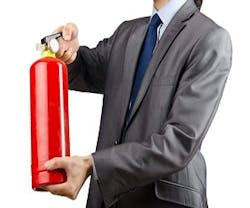Ensuring that Fire Extinguishers Work
The Intl. Fire Code and the National Fire Protection Association (NFPA) both mandate that fire extinguishers be installed in almost every building that offers access to the public. NFPA 10: Standard for Portable Fire Extinguishers, 2007 Edition, states: "Fire extinguishers shall be provided for the protection of both the building structure and the occupancy hazards contained therein regardless of the presence of any fixed fire suppression systems." Additionally, it explains that portable fire extinguishers are intended as a first line of defense to cope with fires of limited size, and the selection and installation of extinguishers is independent of whether the building is equipped with automatic sprinklers, standpipe and hose, or other fixed protection equipment.
Since fire extinguishers are a fact of life, for them to be an effective tool at the time of an emergency, it's necessary that they be inspected on a monthly basis. Maintenance should be performed by a trained and certified person at least annually.
Inspection
Inspection, which is performed by the owner of the facility or a designated agent at a minimum of 30-day intervals, is necessary to ensure that fire extinguishers remain unobstructed and accessible, and are in the proper location and not obscured from view. It also ensures that the pressure gauge or indicator (if so equipped) is in the operable range and that there's no physical damage to the extinguisher. If any deficiency is noted during this inspection, the fire extinguisher should be removed from service, and maintenance should be performed by a trained, certified person. Usually, this maintenance is performed by an independent company with the appropriate service manual(s), the proper types of tools, recharge materials, lubricants, and the manufacturer's recommended replacement parts.
Maintenance
Maintenance is required at least annually on all extinguishers, and is usually performed by an independent company. In addition to the steps identified during an inspection, maintenance procedures should also include a thorough examination of the basic elements of a fire extinguisher and its components, as well as follow the procedures detailed in the manufacturer's service manual. Mechanical parts; the extinguishing agent of cartridge- or cylinder-operated dry chemical, stored pressure, loaded stream, and pump tank extinguishers; expelling means; and physical appearance all require attention.
Statistics show that, when a portable fire extinguisher is used, it puts out the fire 94 percent of the time - typically within the first 2 minutes. When a fire is extinguished early, deaths, injuries, and property damage are significantly minimized. A fire extinguisher, however, should only be used once the fire department is called and everyone is safe.
When it comes to fire extinguishers, maintenance is critical. The 2007 Edition of NFPA 10 provides the most recent guidelines for regular inspection and maintenance of portable fire extinguishers. Manufacturers can also offer additional product information, if needed.
Jim Widmer is president of the Cleveland-based Fire Equipment Manufacturers' Association (FEMA). For more information, or to access educational materials, visit FEMA's website.
